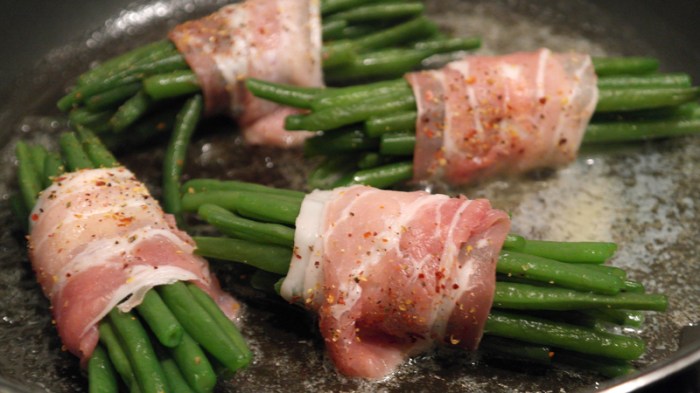
Bacon Wrapped Green Beans: A Culinary Delight
Bacon wrapped green beans, a simple yet irresistible combination of savory and sweet, has become a culinary staple across the globe. The crispness of the bacon perfectly complements the tender green beans, creating a symphony of flavors that tantalizes taste buds.
From elegant dinner parties to casual backyard barbecues, this dish consistently steals the show, captivating both seasoned foodies and casual diners alike. The appeal of bacon wrapped green beans lies not only in its taste but also in its versatility, lending itself to a myriad of variations and adaptations, making it a culinary chameleon that adapts to any occasion.
The origins of this beloved dish are shrouded in culinary mystery, but it is believed to have emerged as a simple and satisfying way to enhance the flavor of green beans. Over time, bacon wrapped green beans have evolved into a culinary icon, embraced by chefs and home cooks alike.
Its enduring popularity is a testament to the power of simple, yet delicious, combinations that transcend culinary trends and generations.
Cooking Techniques and Tips
Bacon-wrapped green beans offer a delightful combination of crispy bacon and tender green beans. Achieving this perfect balance requires selecting the right cooking method and mastering a few essential tips.
Cooking Methods
The most common cooking methods for bacon-wrapped green beans include baking, pan-frying, and grilling. Each method offers unique advantages and disadvantages.
- Baking: This method is the most convenient and hands-off approach. It involves placing the wrapped green beans on a baking sheet and cooking them in a preheated oven. Baking allows for even cooking and prevents over-browning of the bacon.
However, it may not result in the same level of crispiness as pan-frying or grilling.
- Pan-frying: Pan-frying offers a quicker cooking time and allows for more control over the level of crispiness. However, it requires more attention and may lead to uneven cooking if the pan is overcrowded.
- Grilling: Grilling provides a smoky flavor and crispy bacon, but it can be challenging to achieve even cooking, especially if the grill is not evenly heated.
Tips for Achieving Crispy Bacon and Tender Green Beans
- Use high-quality bacon: Thicker bacon tends to hold its shape better and results in a crispier texture. Choose bacon with a high fat content for optimal flavor and crispiness.
- Partially cook the bacon before wrapping: This helps ensure the bacon cooks evenly and prevents the green beans from becoming soggy. You can achieve this by pan-frying the bacon strips for a few minutes before wrapping them around the green beans.
- Secure the bacon with toothpicks: This prevents the bacon from unraveling during cooking and ensures even cooking of the green beans.
- Avoid overcrowding the pan or baking sheet: This allows for proper air circulation and prevents steaming, which can result in soggy green beans.
- Flip the green beans halfway through cooking: This ensures even cooking and prevents the bacon from burning on one side.
Common Mistakes to Avoid, Bacon wrapped green beans
- Overcrowding the pan or baking sheet: This can lead to uneven cooking and soggy green beans.
- Using too much bacon: Excessive bacon can overwhelm the flavor of the green beans and make the dish too greasy.
- Not securing the bacon properly: Unsecured bacon can unravel during cooking, leading to uneven cooking and a messy presentation.
- Overcooking the green beans: Overcooked green beans become mushy and lose their flavor. Cook them until just tender-crisp.
- Not letting the bacon rest before serving: This allows the bacon to crisp up further and prevents the green beans from becoming soggy.
Serving and Presentation: Bacon Wrapped Green Beans

Bacon-wrapped green beans are a delicious and versatile side dish that can be enjoyed in many different ways. Serving and presentation play a crucial role in elevating this dish from simple to spectacular. By carefully considering accompaniments, plating techniques, and visual appeal, you can create a memorable dining experience for any occasion.
Accompaniments
The ideal accompaniments for bacon-wrapped green beans depend on the overall flavor profile of your meal and your personal preferences. Here are some ideas:
- Creamy and Tangy:A creamy sauce, such as a béarnaise or hollandaise, can complement the salty and savory flavors of the bacon. A tangy element, like a lemon wedge or a sprinkle of fresh herbs, adds brightness and balance.
- Sweet and Savory:For a contrasting flavor profile, consider serving bacon-wrapped green beans with a sweet and tangy chutney or a drizzle of balsamic glaze.
- Spicy Kick:To add a touch of heat, try a spicy dipping sauce or a sprinkle of chili flakes.
- Fresh and Crunchy:A fresh salad with a light vinaigrette or a side of crunchy bread can provide a refreshing contrast to the rich and savory bacon-wrapped green beans.
Presentation Techniques
The way you present bacon-wrapped green beans can significantly impact their visual appeal and overall dining experience. Here are some creative ideas:
- Fan-Shaped Arrangement:Arrange the green beans in a fan shape on a platter, with the bacon ends facing outward. This creates a visually appealing and elegant presentation.
- Skewer Presentation:Thread the bacon-wrapped green beans onto skewers for a more rustic and casual look.
- Individual Portions:Serve each guest a small portion of bacon-wrapped green beans in a ramekin or a small bowl. This allows for a more intimate and personalized dining experience.
- Garnish with Herbs and Spices:Add a touch of freshness and color to your presentation by garnishing the bacon-wrapped green beans with fresh herbs, such as parsley or chives, or a sprinkle of paprika or chili flakes.
Plating for Different Occasions
The plating style for bacon-wrapped green beans can vary depending on the occasion.
- Formal Dinners:For a formal dinner, present the bacon-wrapped green beans on a rectangular platter, arranged in a neat and symmetrical pattern. Use a simple and elegant garnish, such as a sprig of rosemary or a few fresh thyme sprigs.
- Casual Gatherings:For a casual gathering, consider a more rustic presentation. Serve the bacon-wrapped green beans in a large bowl or on a wooden platter, with a simple garnish of chopped parsley or chives.
Nutritional Information

Bacon-wrapped green beans are a popular appetizer or side dish, but their nutritional value is a subject of debate. While they offer some nutrients, the high fat content from the bacon makes them a less healthy option compared to other vegetable dishes.
Nutritional Content
Bacon-wrapped green beans are primarily composed of fat, protein, and carbohydrates.
- Fat:The bacon contributes significantly to the fat content, primarily saturated fat.
- Protein:Both the bacon and green beans provide protein, but the bacon contributes a larger amount.
- Carbohydrates:Green beans are the primary source of carbohydrates in this dish.
The dish also contains some micronutrients, including:
- Vitamin A:Green beans are a good source of vitamin A, essential for vision, immune function, and cell growth.
- Vitamin C:Green beans also provide vitamin C, an antioxidant that supports immune function and collagen production.
- Potassium:Green beans are a source of potassium, a mineral that helps regulate blood pressure and muscle function.
- Iron:Both bacon and green beans contain iron, essential for red blood cell production and oxygen transport.
Health Benefits and Drawbacks
While bacon-wrapped green beans provide some nutrients, their high fat content outweighs the potential benefits.
- Potential Health Benefits:The green beans contribute fiber and vitamins, which can support digestion and overall health.
- Potential Drawbacks:The high saturated fat content from the bacon can increase the risk of heart disease and other health problems. Excessive consumption of processed meats, like bacon, has been linked to an increased risk of certain cancers.
Nutritional Comparison
Here is a table comparing the nutritional value of bacon-wrapped green beans to other similar dishes:
| Dish | Calories | Fat (g) | Protein (g) | Carbohydrates (g) |
|---|---|---|---|---|
| Bacon-wrapped Green Beans (1 serving) | 150-200 | 15-20 | 5-10 | 5-10 |
| Steamed Green Beans (1 serving) | 30-40 | 1-2 | 2-3 | 7-8 |
| Roasted Green Beans (1 serving) | 50-60 | 3-4 | 3-4 | 8-9 |
The Future of Bacon-Wrapped Green Beans
The bacon-wrapped green bean, a culinary classic, is poised for a future brimming with innovation and exciting possibilities. This seemingly simple dish has captured hearts and palates for decades, but the culinary landscape is constantly evolving, and the bacon-wrapped green bean is not immune to these shifts.
Emerging Trends and Innovations
The future of bacon-wrapped green beans is characterized by a focus on elevated techniques, bold flavor combinations, and creative presentations. This evolution reflects a growing appreciation for culinary artistry and a desire for dishes that are both visually appealing and gastronomically satisfying.
- Gourmet Green Beans:The humble green bean is being elevated with the use of specialty varieties, like purple beans, flat beans, or even heirloom beans, offering a wider spectrum of textures and flavors. This creates a more complex and interesting culinary experience.
- Beyond Bacon:While bacon remains a beloved staple, adventurous chefs are experimenting with alternative wrappings. Smoked duck breast, prosciutto, or even crispy pancetta offer unique flavor profiles and textures. The use of plant-based alternatives like tempeh bacon or seitan bacon caters to dietary preferences and adds a contemporary touch.
- Flavor Infusion:The focus on flavor is extending beyond the wrapper. Chefs are infusing the green beans themselves with exotic spices, herbs, or even fruit purees. This adds depth and complexity to the dish, creating a symphony of tastes.
- Creative Presentations:The presentation of bacon-wrapped green beans is undergoing a transformation. Instead of the traditional skewer or simple arrangement, chefs are exploring plating techniques that are both artistic and visually captivating. This could include plating the dish on a bed of creamy polenta, a vibrant salsa, or a sprinkle of edible flowers.






